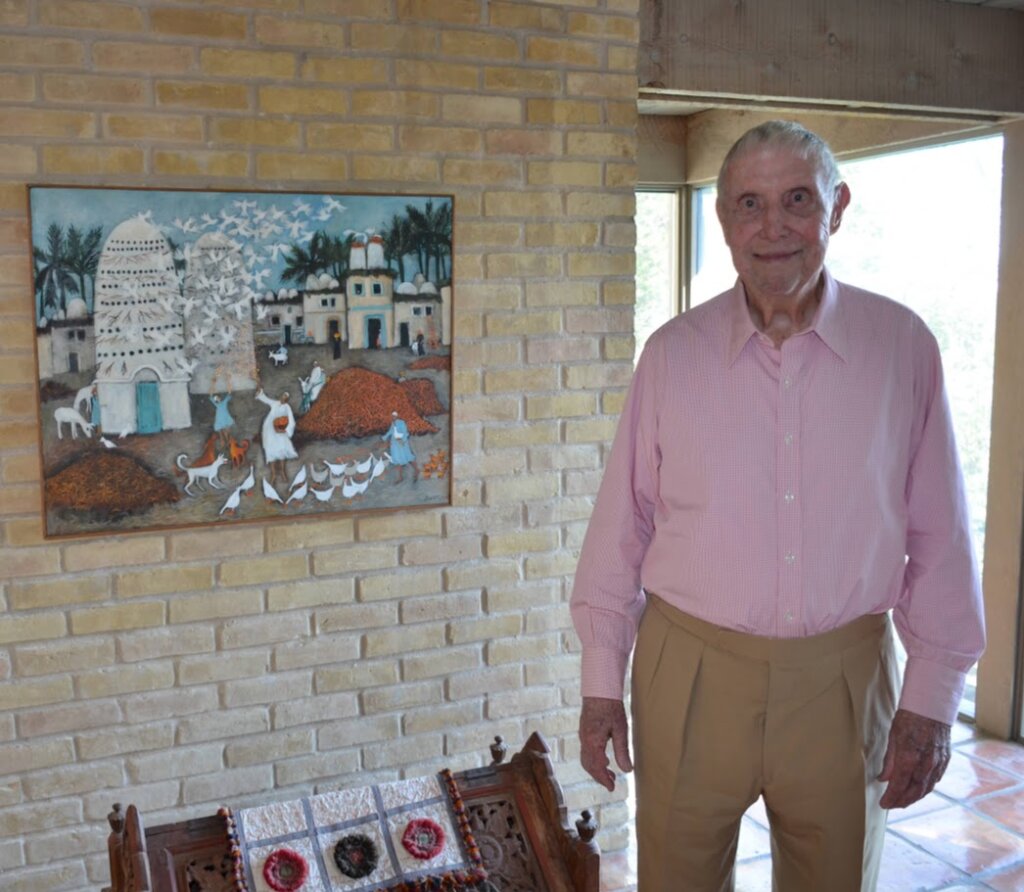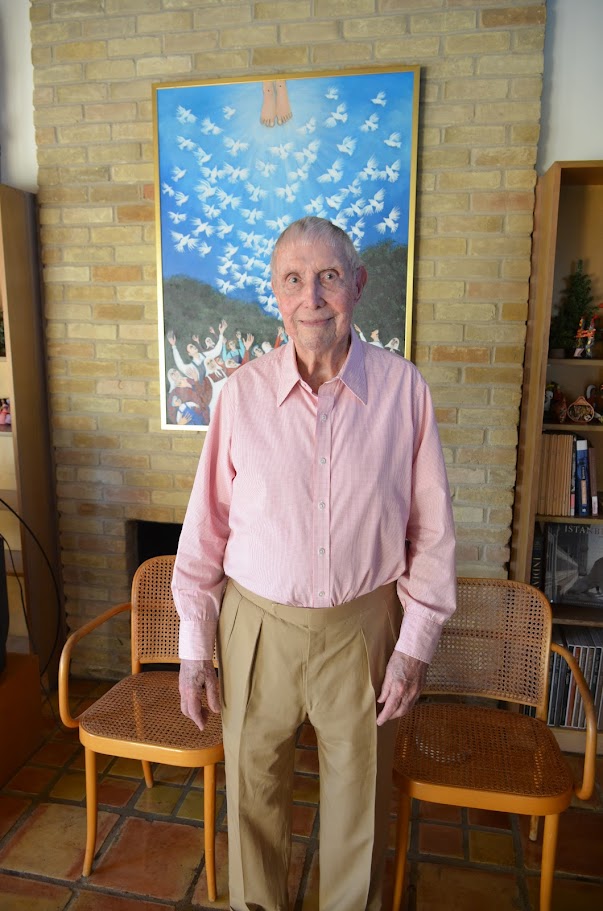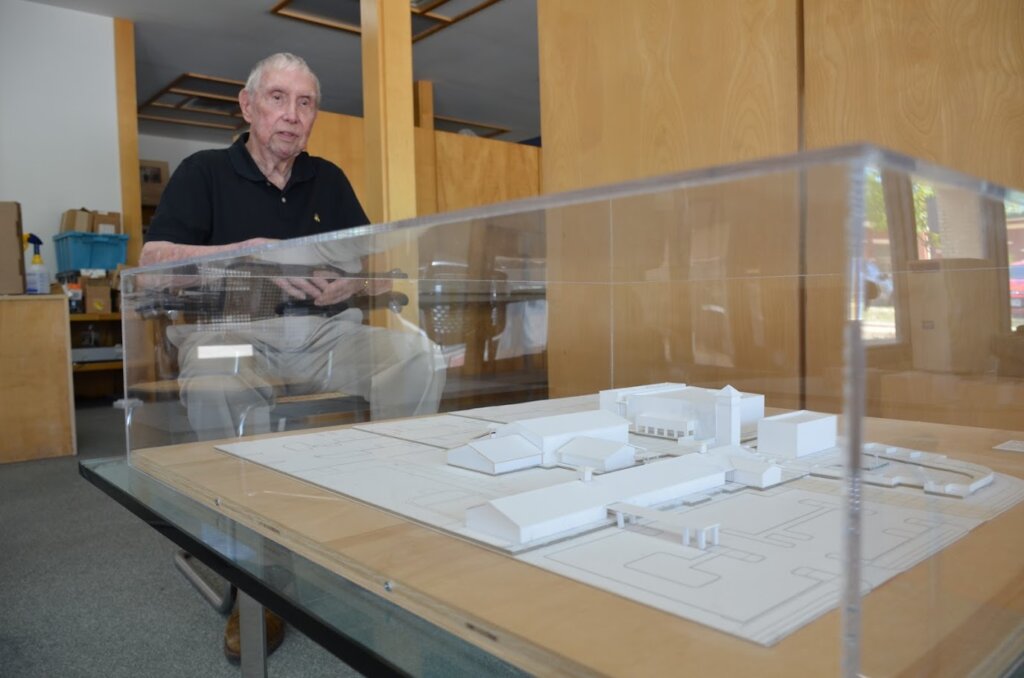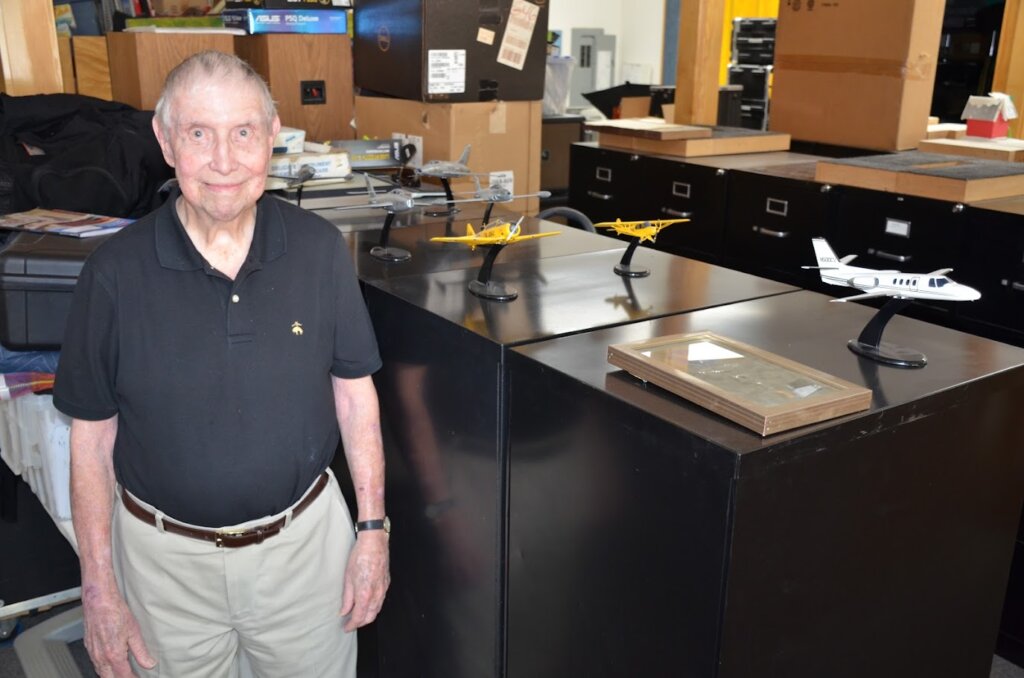

By LYNETTE HAALAND
Four Points News
David Barrow Jr. – a University of Texas graduate, former U.S. Air Force fighter pilot, architect and family man – helped shape Northwest Hills. His dad and uncle had the vision to develop the land and his mom coined its name. Barrow – who still goes into the office regularly at age 92 – has also played a significant role in this scenic community.
There were multiple developers of Northwest Hills – which was the first housing expansion of Austin outside of the central area – between the 1940s to the 1980s. Many employed Barrow and Stahl Architects as professional planners as well as engineering consultants.
An early land-use plan drawn by Barrow and Stahl has areas labeled “Flat Land,” “Rough Land” and “Really Rough Land,” along with a layout of nodes and road routes.
With those rough plans, Barrow has made his mark, incorporating the natural beauty of the land into every project.

Looking back
Barrow was born June 28, 1931 in a house at Avenue H north of E 45th Street. A decade later, his family moved to Windsor Road.
He shared he was grateful to be raised in a Christian home and that has always been important to his family.
Barrow attended Baker, Robert E. Lee and Wooldridge elementary schools, University Junior High and Austin High School.
When he was young, Barton Springs was a good swimming pool off the trolley.
In the 1940s, Barrow remembers coming out to this wooded land Northwest of Austin. Today this area is bordered by FM 2222, Capital of Texas Loop 360, MoPac Loop 1 and 183 North.
It was his father, David Brown Barrow Sr., who came out to the area for exercise when he was young and first got “eyeballs” on this beautiful land.
In 1944, Barrow Sr. and his brother Edward Rowland Barrow began accumulating land in Northwest Austin. They saw the value of the land around the quarry.
Barrow Sr. shared in his oral history about acquiring land from the Milton Hart family — namesake of Hart Lane — the Wendlandt Estate and Wilbur Allan’s family. By the end of the 1950s, his team owned or had options on more than 2,500 acres which was more than half the total in the district.
The Austin American-Statesman summed up the start of Northwest Hills in 2018: “The late David Brown Barrow Sr. – who moved to Austin in 1909, served in the Army during World War I and became an almost accidental co-founder of Northwest Hills after World War II – had roamed the wild verges of Austin as a youth. That liberating experience helped inspire his designs for a green neighborhood named with romantic whimsy — Northwest Hills — by his wife (Nelle).”
Barrow Jr. was inspired to go into architecture at the University of Texas after reading the autobiography of famed architect Frank Lloyd Wright, who incorporated nature in all that he built.
“I entered UT in 1948 and graduated in 1955,” he shared. “I got a BS in business and a BS in architecture and a commission through ROTC as a USAF 2nd Lieutenant at UT.”
Barrow became a jet fighter pilot with the U.S. Air Force where he was Active Duty and in the Reserves from September 2, 1955 to April 1, 1968.
One story that stuck out in his mind as a pilot was “checking out in the F100A that would takeoff, make two turns and level off at 40,000 feet.”

Barrow met his wife Lu Ann at a party on Lake Austin in 1955 and he recalls, “She was the girl in the white dress.” The two got married on December 7,1956.
Lu Ann Barrow – who entered the University of Texas studio art program in 1952 and received a bachelor of fine arts degree with a minor in anthropology in 1956 – became a well-known folk artist.
Lu Ann left her legacy in art. She passed away on July 25, 2020.

The couple had two sons. David Brown Barrow III was born in 1959 and Thomas Edward Barrow was born in 1962 and passed away August 11, 1995.
In 1961, Barrow and Charles Stahl started their firm Barrow and Stahl Architects.
He would ultimately design 11 homes in the Northwest Hills area as well as St. Matthew’s Episcopal Church.
“When St. Matthew’s was on Ridge Oak, I made a master plan which included expansion, but there was not room to expand the parking,” Barrow shared. “So St. Matthew’s moved to Mesa and Steck Avenue in 1979 where I was the architect for the new parish hall, bell tower and education building. In 1986, St. Matthew’s added a sanctuary building for which I also was the architect.”

Through the decades, Barrow also designed office buildings, other churches, commercial and shopping centers in Austin. He designed federal buildings in South Austin as well.
Family tradition
Like father, like son, Barrow Sr. also enjoyed working with the natural beauty of Northwest Austin.
“I have used extreme care in laying out the area … in order to make it very attractive,” shared Barrow Sr. in 1964. “Of course, nature’s responsible for a whole lot of that. That area’s beautiful, and you have beautiful views from most places, in some places views of the lake and the western mountains.”
Barrow Jr. would later incorporate these views of Lake Austin, Cat Mountain and many live oaks into his own home: “I designed and built my home in 1973 to follow the contours of the land and take advantage of the views from the site.”
The Barrows could be considered the original “first family of Northwest Hills”. They used their vision to recognize this captivating place and they used their talents to develop and design around its beauty – preserving it for so many families over the last eight decades.

David Barrow Jr. became a jet fighter pilot with the U.S. Air Force where he was Active Duty and in the Reserves from September 2, 1955 to April 1, 1968.
Northwest Austin Development
By David Brown Barrow, Jr. and David Brown Barrow III
David Brown Barrow Sr. and his brother Edward Rowland Barrow began accumulating land in Northwest Austin in 1944.
In 1950 Barrow began to subdivide the land east of Mount Bonnell and called the development Balcones Park. They completed the development of Balcones Park in ten sections, comprising 280 lots in 1959.
In 1962 they formed Austin Corporation and began acquiring land west of Balcones Drive and north of FM 2222. They named the proposed development Northwest Hills.
Based on the experience with Balcones Park, they realized the importance of having a large acreage in one block to control the nature of the development. In the
accumulation of land for Northwest Hills they finally either owned or controlled by option nearly 2,500 acres in one of the most desirable areas close to Austin.
In the work done in Balcones Park, Barrow felt that he had a natural talent for designing residential subdivisions. He had what might be called a “feel” for the land where the streets in land of irregular topography should be, laying out lots and streets to save the most trees and otherwise developing the land in an attractive manner.
The development of Northwest Hills continued rapidly and is now recognized as one of the largest and one of the best such developments in or around Austin.
(The Barrow family refused to sell too many adjacent lots to the same builder in order to avoid a “cookie-cutter” feel,” according to the Austin American-Statesman.)
The last section was named “Cat Mountain” and was completed in 1972. Civil Engineer Jeryl Hart and the architectural firm of Barrow and Stahl Architects (started in 1962 by David Barrow, Jr. and Charles Stahl) participated in the design and layout of the streets and lots.
The area did finally extend from MoPac Boulevard on the east, 2222 on the south and Spicewood Springs Road on the north.
The Master Plan had east-west Far West Boulevard and north-south Mesa Drive as
major streets of the area. Far West Boulevard was intended to run from a west
intersection with 2222 and an east continuation to Mueller Airport.
(According to the Statesman, Barrow Sr., who served on the Austin Planning Commission, is credited with lobbying for the construction of MoPac, which allowed Northwest Hills residents to commute downtown more directly than by taking North Lamar Boulevard. He died in 1972.)
The west extension was canceled by Austin’s City Manager and the east extension was canceled by the Austin City Council in response to protests by the Shoal Creek neighborhood.
Texas Crushed Stone company had a large gravel pit along what it now Far West
Boulevard and when they moved to Georgetown, Austin Corporation acquired the
property to become the “downtown” of Northwest Hills. It eventually included Murchison Middle School, Far West Retail Shopping Center and the US Post Office there now.
Other commercial areas were located at the intersection of Mesa Drive and Spicewood Springs Road and at the intersection of Dry Creek Drive and FM 2222.
The main development spanned over 40 years until the 1980s and today the area has more than a dozen subdivisions.
Northwest Hills has been enjoyed for many years now by its residents and commercial buildings owners and tenants.
Lu Ann Barrow’s artistic legacy

Lu Ann Barrow’s paintings were featured at the Wagner or Wunderlich galleries, Austin Museum of Art, and at the annual Fiesta events for Laguna Gloria Art Museum. Barrow was represented by Valley House Gallery & Sculpture Garden in Dallas starting in 1993.
In 1999, former first lady Laura Bush asked her to do a poster for the Texas Book Festival and in 2001 another one for the first National Book Festival.
In 2003, Lu Ann wrote a personal artistic statement.
“I usually begin a painting with a title, something I’ve read or heard, that evoked an immediate image,” Barrow wrote. “For instance, ‘too wet to plow,’ and I could visualize a farmer sitting on his tractor, playing a guitar while the rain comes down outside the barn door. Or, ‘we has us a hallelujah time,” overheard in a checkout line as two ladies talked about an event at their church. I could immediately see the church, the surrounding grounds, the trees beyond and the people celebrating as they boogied out of the church. For me, painting is a language I’ve been blessed with and can use to gather what I’ve seen, read, heard or experienced and share it with the viewer, a way to say visually ‘let me tell you.’”
Art historian Karen Pope said this about Lu Ann Barrow in an Austin American Statesman tribute after her death in 2020: “This gracious, quiet, gentle little lady communicated tremendous joy through a fusion of folk-style genre scenes with biblical subjects. All her works are characterized by brilliant color, strong, simply-drawn figures and humorous settings and details.”
